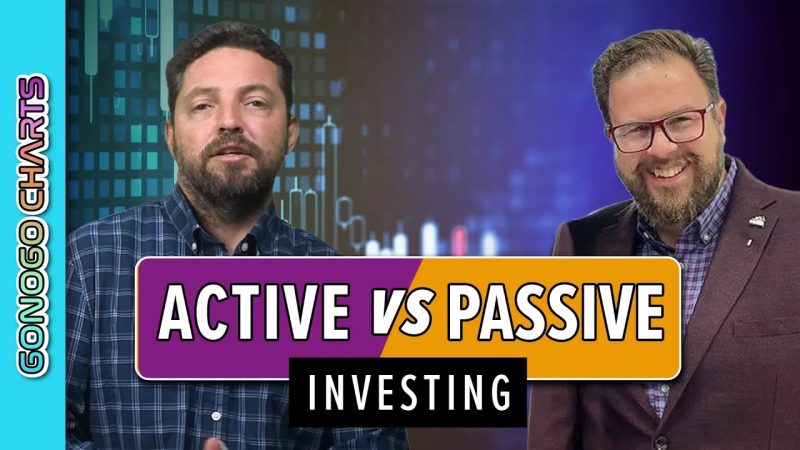January 19, 2024
Unlock the Secrets of Investing: GNG TV Debates Active vs. Passive Strategies!
 Title: Active vs. Passive Investing: Understanding the Pros and Cons
Introduction:
Investing in financial markets can be a daunting task, especially if you're new to the world of investing. Many individuals are often divided between two popular investment strategies: active and passive investing. Both approaches have their own set of pros and cons, and understanding them can help you make informed decisions about your investment strategy. In this article, we will explore the differences between active and passive investing, their benefits, drawbacks, and how they fit into different investment goals.
Understanding Active Investing:
Active investing involves a more hands-on approach, where investors actively manage their portfolios, continually monitoring and adjusting their holdings. Active investors aim to outperform the market through diligent research, analysis, and timely decision-making. They rely on their skills, knowledge, and intuition to identify undervalued stocks or assets that they believe will generate higher returns.
Pros of Active Investing:
1. Potential for higher returns: Active investors have the opportunity to outperform market benchmarks when they make well-timed investment decisions or capitalize on market inefficiencies.
2. Flexibility and adaptability: Active investors can react swiftly to market trends, adjusting their portfolios as market conditions change.
3. Active involvement: For investors who enjoy hands-on participation in their investments, active investing offers an engaging and challenging approach.
Cons of Active Investing:
1. Higher costs: Active investing typically incurs higher costs due to frequent trading, higher commission fees, and management expenses.
2. Higher risk: Frequent trading and attempting to time the market can expose investors to increased risks.
3. Time-consuming: Active investing demands significant time and effort to stay updated on market trends, research companies, and analyze financial data.
Understanding Passive Investing:
Passive investing, also known as index investing, involves a more laid-back approach where investors build a portfolio mimicking a specific market index. Instead of trying to outperform the market, passive investors aim to replicate its performance.
Pros of Passive Investing:
1. Lower costs: Passive investing generally incurs lower expenses as it involves fewer trades, resulting in lower transaction costs and potentially lower management fees.
2. Diversification: By investing in index funds, passive investors gain exposure to a broad range of assets, spreading risk across the entire market.
3. Simplicity: Passive investing requires less time and effort, making it suitable for investors who prefer a more hands-off approach.
Cons of Passive Investing:
1. Average returns: Passive investors can only expect to receive average market returns, as they are not attempting to outperform the market.
2. Limited control: Passive investors must accept the performance of the entire index, regardless of the individual performance of the securities within it.
3. Minimal involvement: Passive investors have limited input in the investment process and cannot capitalize on specific market opportunities or make strategic decisions.
Conclusion:
Active and passive investing are two distinct strategies with their own sets of advantages and drawbacks. Deciding which strategy to pursue largely depends on an individual's financial goals, risk tolerance, time commitment, and personal beliefs about market efficiency. Active investing can potentially deliver higher returns but requires diligent effort, expertise, and higher costs. In contrast, passive investing provides simplicity, diversification, and lower costs but may limit potential returns. Ultimately, finding the right balance between active and passive approaches may offer a diversified strategy that aligns with your investment goals and risk appetite.
Title: Active vs. Passive Investing: Understanding the Pros and Cons
Introduction:
Investing in financial markets can be a daunting task, especially if you're new to the world of investing. Many individuals are often divided between two popular investment strategies: active and passive investing. Both approaches have their own set of pros and cons, and understanding them can help you make informed decisions about your investment strategy. In this article, we will explore the differences between active and passive investing, their benefits, drawbacks, and how they fit into different investment goals.
Understanding Active Investing:
Active investing involves a more hands-on approach, where investors actively manage their portfolios, continually monitoring and adjusting their holdings. Active investors aim to outperform the market through diligent research, analysis, and timely decision-making. They rely on their skills, knowledge, and intuition to identify undervalued stocks or assets that they believe will generate higher returns.
Pros of Active Investing:
1. Potential for higher returns: Active investors have the opportunity to outperform market benchmarks when they make well-timed investment decisions or capitalize on market inefficiencies.
2. Flexibility and adaptability: Active investors can react swiftly to market trends, adjusting their portfolios as market conditions change.
3. Active involvement: For investors who enjoy hands-on participation in their investments, active investing offers an engaging and challenging approach.
Cons of Active Investing:
1. Higher costs: Active investing typically incurs higher costs due to frequent trading, higher commission fees, and management expenses.
2. Higher risk: Frequent trading and attempting to time the market can expose investors to increased risks.
3. Time-consuming: Active investing demands significant time and effort to stay updated on market trends, research companies, and analyze financial data.
Understanding Passive Investing:
Passive investing, also known as index investing, involves a more laid-back approach where investors build a portfolio mimicking a specific market index. Instead of trying to outperform the market, passive investors aim to replicate its performance.
Pros of Passive Investing:
1. Lower costs: Passive investing generally incurs lower expenses as it involves fewer trades, resulting in lower transaction costs and potentially lower management fees.
2. Diversification: By investing in index funds, passive investors gain exposure to a broad range of assets, spreading risk across the entire market.
3. Simplicity: Passive investing requires less time and effort, making it suitable for investors who prefer a more hands-off approach.
Cons of Passive Investing:
1. Average returns: Passive investors can only expect to receive average market returns, as they are not attempting to outperform the market.
2. Limited control: Passive investors must accept the performance of the entire index, regardless of the individual performance of the securities within it.
3. Minimal involvement: Passive investors have limited input in the investment process and cannot capitalize on specific market opportunities or make strategic decisions.
Conclusion:
Active and passive investing are two distinct strategies with their own sets of advantages and drawbacks. Deciding which strategy to pursue largely depends on an individual's financial goals, risk tolerance, time commitment, and personal beliefs about market efficiency. Active investing can potentially deliver higher returns but requires diligent effort, expertise, and higher costs. In contrast, passive investing provides simplicity, diversification, and lower costs but may limit potential returns. Ultimately, finding the right balance between active and passive approaches may offer a diversified strategy that aligns with your investment goals and risk appetite.
If you would like to delve into the world of investment topics , go to our partner project Wall Street Wizardry


